A Step-by-Step Guide: How to Build a Deck
Building a deck can be a wonderful addition to your home, providing a versatile space for relaxation, entertaining guests, or enjoying outdoor activities. Building a deck may seem like a daunting task, but with proper planning and the right tools, it can be a rewarding DIY project. In this step-by-step guide, we will walk you through the process of building a deck from start to finish.
Step 1: Design and Planning
The first step in building a deck is to carefully plan and design your project. Consider the size, shape, and location of your deck, as well as any additional features you may want, such as stairs, railing, or built-in seating. Take into account your local building codes and regulations, ensuring compliance with any necessary permits. Sketch out your design and create a materials list to estimate the quantity of lumber, hardware, and other materials you’ll need.
Step 2: Gather Materials and Tools
Once you have your design finalized, You will need to start making design decisions. What type of material will you use to frame your deck, as well as gather all the necessary materials and tools. The primary material for your deck will likely be pressure-treated lumber, which is durable and resistant to rot and insect damage. Other materials may include concrete footings, galvanized screws or nails, joist hangers, and decking boards. You will also want to ensure you have the proper tools on hand to complete the task, such as a circular saw, drill, tape measure, level, and a post hole digger.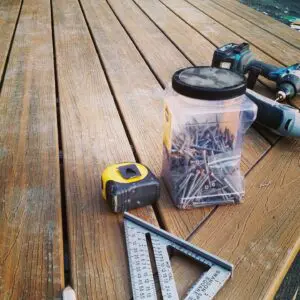
Step 3: Prepare the Site
Prepare the site where your deck will be built by removing any vegetation and leveling the ground. You may want to pour a concrete slab in the area where you will build your deck. It makes for a clean storage area. If necessary, dig and pour concrete footings to provide a solid foundation for your deck’s support posts. Consult local building codes which are easily found online or a structural engineer for guidance on the appropriate depth and diameter for the footings. Ensure the footings are level and allow the concrete to cure fully before proceeding. You also want to be sure that the outside temperature is above 5 degrees celcius to make sure the concrete doesn’t freeze.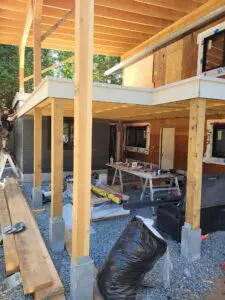
Step 4: Frame the Deck
Now it’s time to start framing your deck. Start by laying out the perimeter of your deck using batter boards and string lines. Install ledger boards to attach the deck to your house, ensuring they are properly flashed and securely fastened. Construct the deck frame using pressure-treated lumber, following your design and local building codes. Install beams, joists, and blocking to provide support and structural integrity. Use joist hangers and galvanized hardware to secure the frame components together. For a more detailed break down on how to frame your deck check out our deck framing post.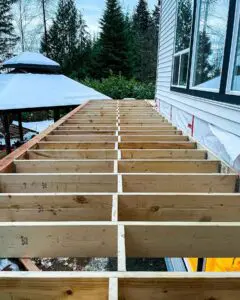
Step 5: Install Decking Boards
With the deck frame in place, it’s time to install the decking boards. Opt for a decking material that suits your style and preferences, such as pressure-treated wood, cedar, or composite decking. Composite decking lasts decades and is a common choice with home owners. Start at one end of the deck and work your way across, ensuring equal spacing between boards. Their are deck board spacers available for purchase. Use stainless steel or coated deck screws for a secure and long-lasting attachment. Cut boards to fit around posts or other obstacles as needed.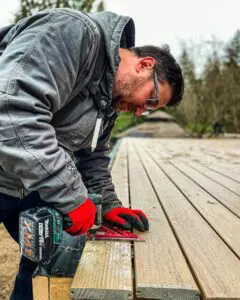
Step 6: Add Railing and Stairs
If your design includes railing or stairs, it’s time to install them. Choose a railing style that complements your deck and meets safety requirements. Install railing posts and attach the railing system securely. For stairs, ensure they are built to code with the proper rise and run measurements. Install risers, treads, and handrails, ensuring everything is sturdy and level.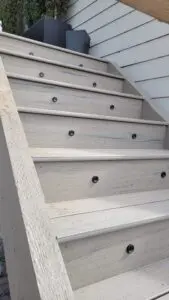
Step 7: Finishing Touches
Once the main structure of your deck is complete, it’s time to add the finishing touches. Sand any rough edges or splintered areas to create a smooth surface. Apply a protective finish, such as stain or sealant, to enhance the appearance and longevity of your deck. Consider adding accessories like built-in seating, planters, or lighting to customize your outdoor space.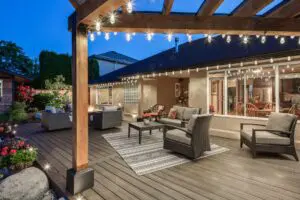
Remember, it’s essential to consult local building codes and regulations, and if you’re uncertain about any step, it’s always recommended to seek professional assistance. Building a deck can be a rewarding project, providing you with a beautiful outdoor space to enjoy for years to come.
What is the difference between wood and composite decking?
Wood decks are commonly constructed out of natural wood materials, such as cedar, pressure-treated and exotic hardwood. Composite decking is made of a blend of wood fibers and plastic. Composite decking is typically more durable and requires less maintenance than wood decking and comes with a 25 – 50 year warranty.
How much does it cost to build a deck?
The cost of building a deck can vary depending on size, material, and llabor costs. On average, the cost to build a deck can range from $3,000 to $15,000 or more.
Are permits required to build a deck?
Permit requirements can vary depending on your location, size and height of your deck. Most often if the finished deck height is not greater than 24″ you do not require a building permit. Generally, a cover that will prevent rain and snow from touching the deck surface will require a building permit. Some cities and municipalities have size limits, allowing the construction of a cover with size limitations. XMT Construction communicates with the building department of your city or town about these details.
How often should I clean and maintain my deck?
Regular cleaning and maintenance can help prolong the life of your deck. Wood decks of any material should be cleaned and sealed annually, while composite or PVC decks require less maintenance and typically only need to be washed 1 or 2 times per annum.
How long does a deck last?
The lifespan of a deck can vary depending on factors such as materials, maintenance, and weather conditions. Wood decks typically last around 10 to 15 years, while composite decks can last 25 years or more with proper maintenance.
What brands of composite decking do you install?
We install TimberTech, Trex and Azek. Azek is a PVC material and a sister company to TimberTech.

